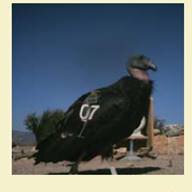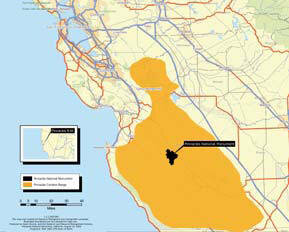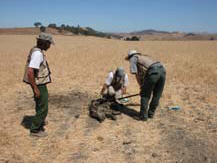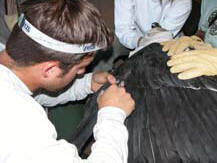Condor Monitoring
Monitoring and managing the wild flock-what it takes to keep condors soaring
Radio and GPS/Satellite Telemetry:
High-Tech Tracking Devices
Prior to release, all of the condors are fitted with either a radio or a GPS/Satellite tag on each wing. Radio transmitters weigh approximately 2 ounces, and have batteries that last from 1 to 3 years. The more advanced GPS/Satellite tags weigh slightly more, but can be solar powered for up to several years. They provide much more detailed location information, but they are very expensive.
You might be lucky enough to catch a glimpse of condor biologists tracking birds from public roadsides near the park. Neighbors can lend assistance by reporting condor sightings or feedings and by allowing biologists access to lands in support of monitoring activities. Biologists will always ask for permission before accessing private land.
This map shows the current range of the Pinnacles and Big Sur condors. GPS/Satellite tags record the location of each bird once each hour, allowing biologists to keep track of the condor's movements. Approximately 1/5 of the population is outfitted with GPS/Satellite tags.

Monitoring: Using a hidden video camera and recording system, biologists record when condors are feeding and how much each bird eats.

24-Hour Service: On-call 24 hours a day, seven days a week, crew members are never truly at rest. "Worry birds" - those birds that haven't fed in over a week, are missing, are prone to approaching people, or are suspected of having ingested lead - are always on the field crews' minds.
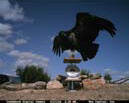
CondorCam: A hidden camera takes photos of the birds as they perch on a scale, giving biologists vital data about each condor's health and weight. More photos are available at www.nps.gov/pinn.
Keeping Condors Healthy
Lead Risk Assessment
The primary concern when condors leave the park is that they will feed on lead-contaminated carcasses. When condors are seen feeding outside the park, biologists investigate carcasses and speak to local landowners to determine the degree of risk of lead poisoning to condors.
Physical Exam
Lead poisoning is a constant threat for condors. In addition, wings can get injured and health issues arise. Every six months, or as problems arise, biologists conduct a physical examination, test each condor's blood lead levels, and replace radio and GPS/satellite transmitters.
Emergency Treatment
Any condor testing positive for high lead levels or showing other health problems is trapped and held for further observations by biologists. If needed, condors with very high levels of lead in their bloodstreams receive chelation treatments. Chelators bind to heavy metals, such as lead, and greatly assist the bird's liver in removing it from the bloodstream.
